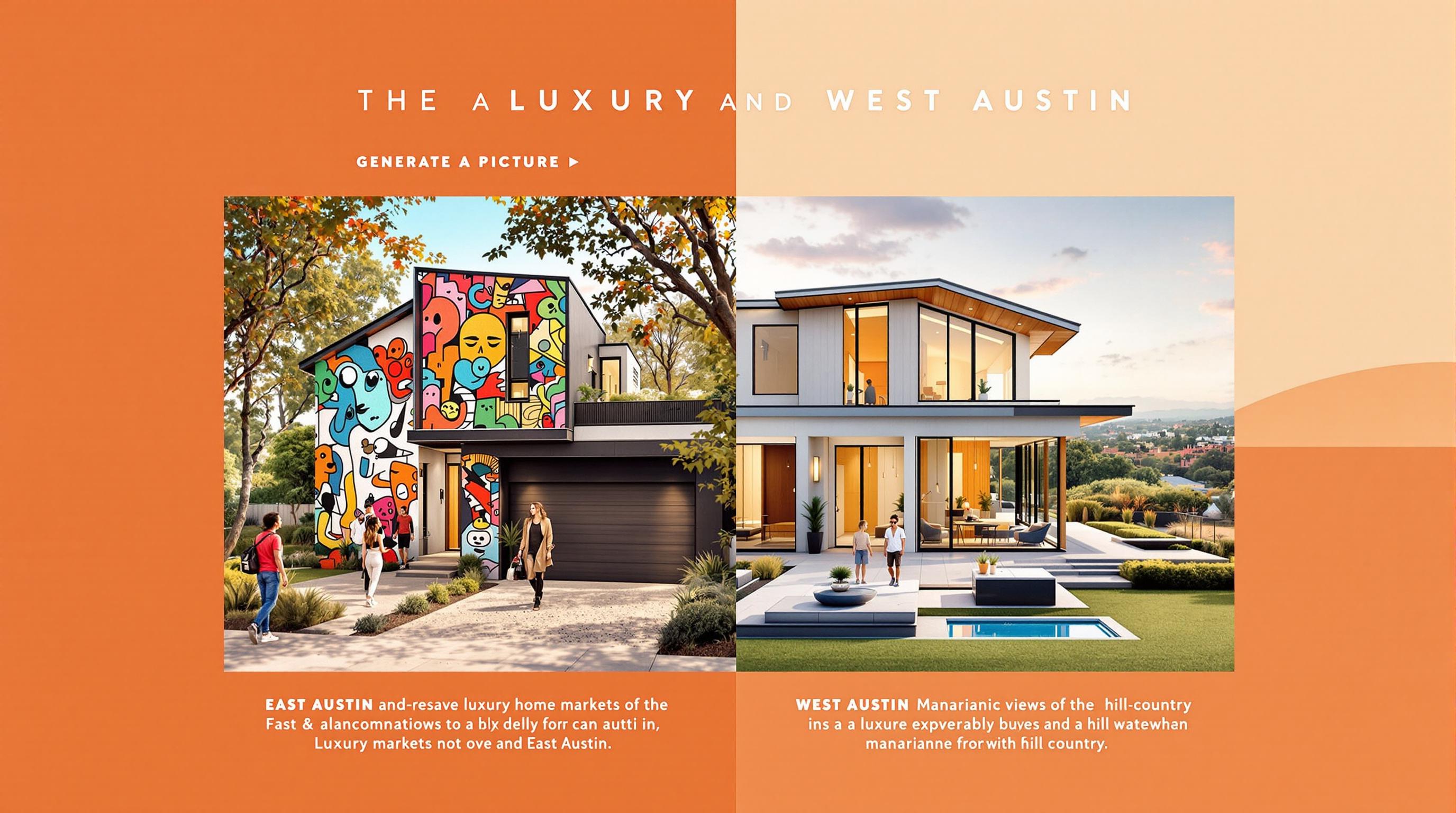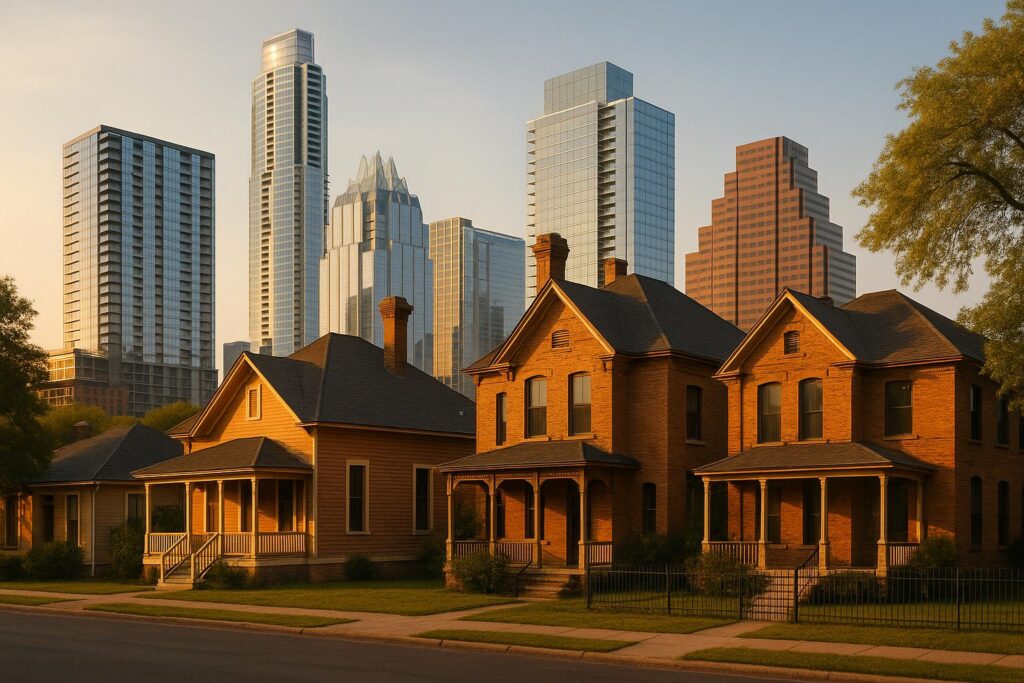Austin’s luxury housing market is split between two distinct trends: East Austin‘s rapid price swings and West Austin‘s steady growth. Here’s what you need to know:
- East Austin: Prices change quickly due to new developments, tech-driven buyers, and speculative investments. It’s a fast-paced market with higher risks and potential for quick returns.
- West Austin: Stable and consistent price growth, driven by limited new construction and demand from established families and retirees. It’s ideal for long-term investments.
Quick Comparison:
| Factor | East Austin | West Austin |
|---|---|---|
| Price Trend | Rapid fluctuations | Gradual, steady growth |
| Buyer Profile | Young professionals, tech workers | High-net-worth families, retirees |
| Development | Rapid new construction | Limited new projects |
| Risk Level | Higher | Lower |
Whether you’re after high-risk, fast returns in East Austin or slow, steady appreciation in West Austin, understanding these differences is key to making smart decisions.
Price Patterns: East vs West Austin
East Austin: Rapid Price Changes
East Austin’s luxury housing market experiences frequent and sharp price changes. New development projects often lead to sudden value increases, which tend to stabilize once the inventory balances out. Factors like gentrification, diverse construction projects, and speculative buying also contribute to this instability. This creates a fast-changing market that contrasts with the steadier trends seen in West Austin.
West Austin: Consistent Price Growth
West Austin’s luxury market, on the other hand, is known for its stability. Limited new construction, a strong tradition of homeownership, and consistent demand contribute to a gradual and predictable rise in property values. This steady growth appeals to buyers looking for long-term investments without the risks associated with volatile price swings.
These contrasting markets cater to different buyer preferences. East Austin’s fast-paced environment may attract those who thrive on timing the market, while West Austin offers a more secure option for those prioritizing steady, long-term growth.
Real Estate Market Update 2024 | Austin TX | Deep Analysis
Buyer Types and Market Impact
Understanding buyer profiles helps clarify the different market trends in Austin.
East Austin: Tech Workers and Young Professionals
East Austin is seeing price shifts largely influenced by tech workers and young entrepreneurs. These buyers are drawn to the area’s urban vibe and modern conveniences, driving demand and reshaping the luxury market.
West Austin: Established Buyers
In contrast, West Austin attracts high-net-worth families and retirees. These buyers prefer the stability of mature neighborhoods and consistent growth, creating a more predictable market.
The preferences of these distinct buyer groups play a key role in shaping the contrasting pricing trends between East and West Austin.
sbb-itb-4c99469
Price Data Analysis
Data shows a clear difference in pricing trends between East and West Austin. In East Austin, prices tend to fluctuate quickly, while in West Austin, prices grow at a more gradual and steady pace.
Market Statistics Comparison
Looking at buyer behaviors, the statistics highlight these pricing patterns. East Austin’s market is more reactive, with prices shifting quickly, particularly influenced by tech-sector buyers. On the other hand, West Austin’s established market supports steady growth, with properties typically priced higher and appreciating incrementally.
These variations are shaped by local market dynamics and buyer preferences. East Austin presents opportunities with greater price swings, while West Austin offers more consistent value growth. This information helps investors weigh the risks and rewards of each area.
Key Neighborhoods and Price Trends
East Austin Growth Areas
Mueller and Holly showcase East Austin’s dynamic luxury market. Mueller, developed on the site of a former airport, experiences noticeable value swings due to its rapid growth. Holly, once a modest area, has become a high-end hotspot, with frequent price shifts reflecting its changing character. This contrasts sharply with the steadier trends seen in West Austin.
West Austin Luxury Districts
Westlake Hills and Barton Creek represent the more stable side of West Austin’s luxury market. Prices here tend to remain consistent, with value changes happening gradually. These well-established neighborhoods highlight the area’s steady approach to luxury real estate, offering a sense of reliability in an otherwise fluctuating market.
Conclusion
East and West Austin’s luxury real estate markets each present distinct dynamics, creating different opportunities and challenges for buyers and sellers. East Austin often sees more price swings due to rapid development and changing demographics, offering both potential rewards and risks. On the other hand, West Austin provides a more stable market, attracting those who value steady and predictable growth.
To navigate these differences, buyers and sellers need tailored strategies:
| Market Area | Buyer Strategy | Seller Strategy |
|---|---|---|
| East Austin | Focus on long-term investments to weather potential price fluctuations. | Take advantage of high-demand periods but stay mindful of possible market corrections. |
| West Austin | Plan for consistent trends that support gradual value appreciation. | Work with local experts to price your property accurately while keeping an eye on market conditions. |
East Austin’s rapid changes contrast with West Austin’s slower, more predictable shifts. Understanding these patterns helps set realistic expectations and guides smarter decision-making.
Whether you’re aiming for faster growth in East Austin or steady appreciation in West Austin, aligning your strategy with the area’s market trends – and partnering with local experts – can make all the difference.





